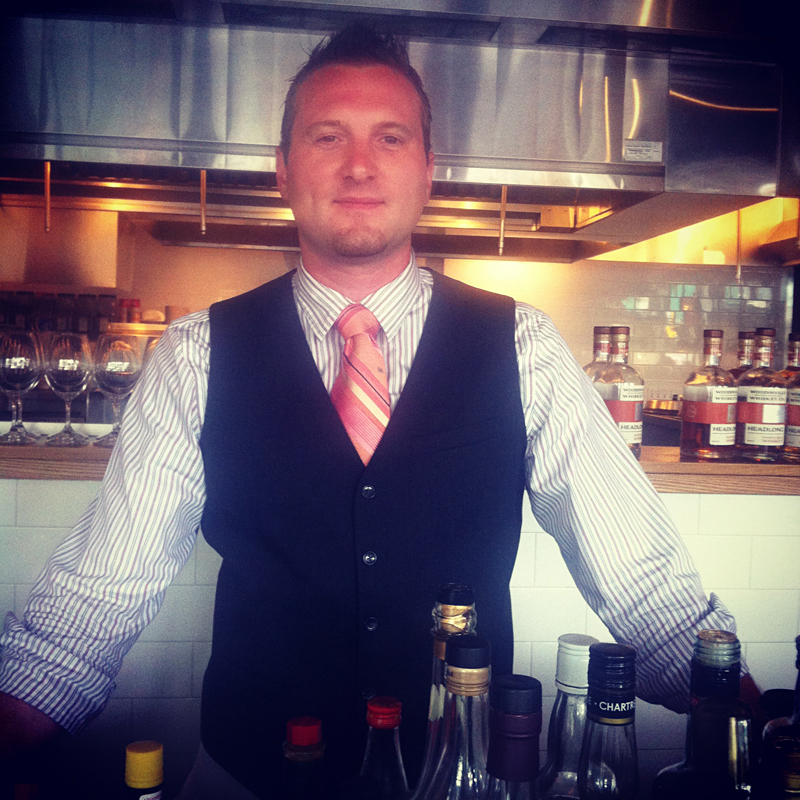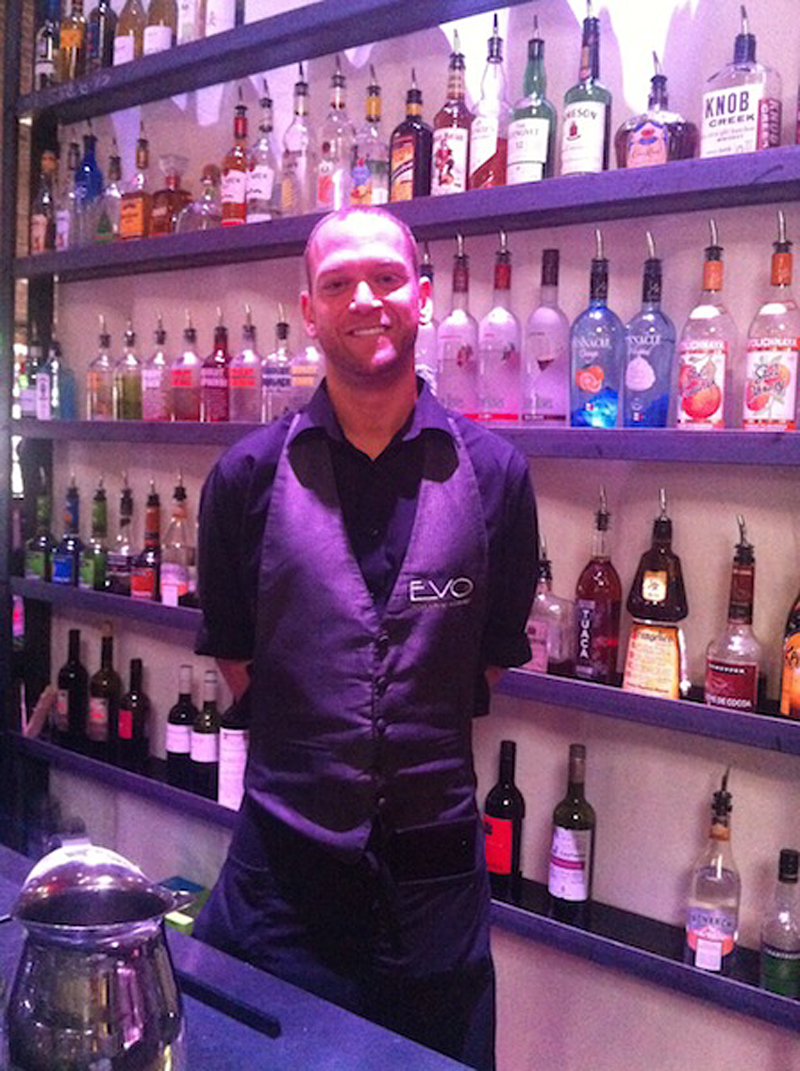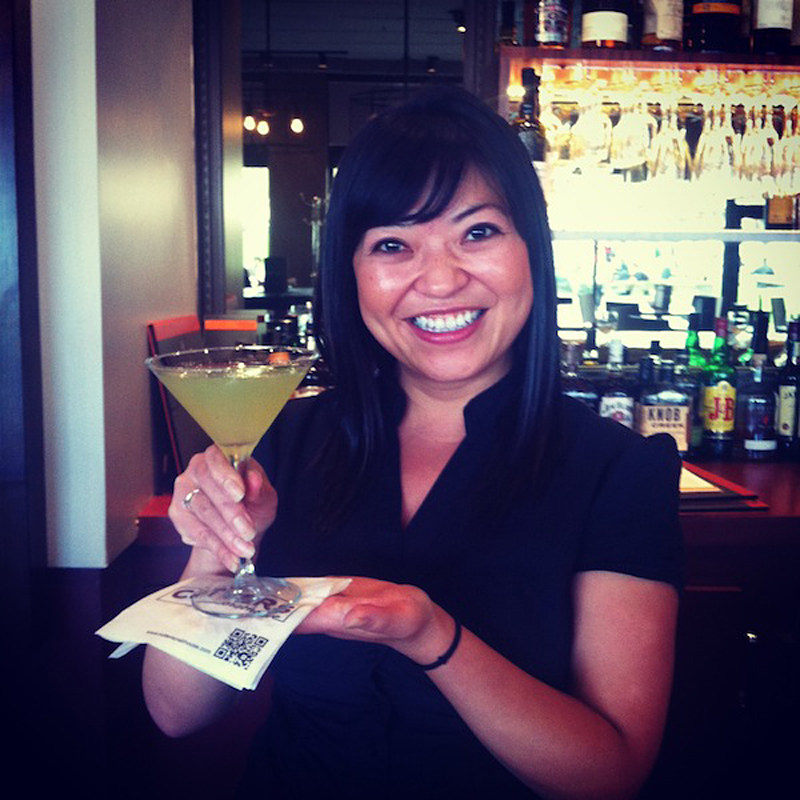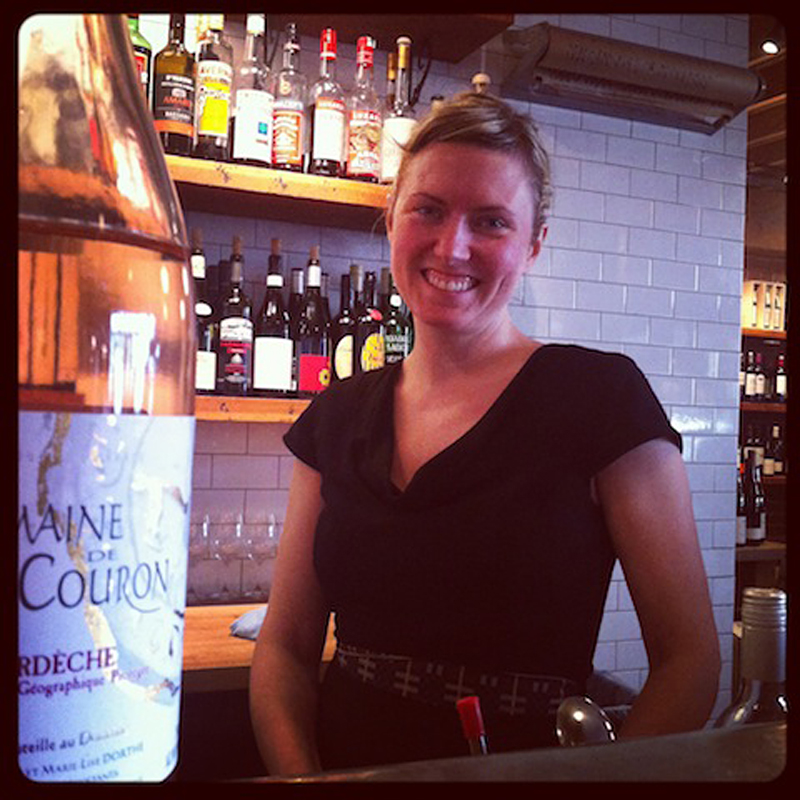Photo courtesy of Marche.It only took 16 years for Daisley Gordon to say he’s worked somewhere in Seattle besides Campagne (with the exception of a one-month stint helping Tom Douglas, as you’ll read about later). Campagne is no more, changing concepts–and name–to become Marche. It quietly opened September 30, offering friends and family a first glimpse of the new space and food in exchange for some honest feedback: “I told them they had to be honest so we wouldn’t walk out of the house with our shirt on backwards or our pants down,” Gordon says of the questionnaire he handed out to the first-timers. Campagne, a stalwart dining destination, has not only traded in its white linen-draped tables, it has literally knocked down the wall between dining and casual mingling with friends in a sexy and fun atmosphere. Instead of getting all gussied up to go to dinner, you can now pop in for some bistro food and a glass of wine at the bar, which takes up nearly half of Marche. So, really, it’s almost impossible not to drink and have a great time here.In this week’s Grillaxin, another Seattle stalwart, Mr. Gordon, talks about taking over ownership of the new restaurant, the future of “fine dining,” and what he’s like to work for (hint: he says fun is overrated) … after the jump!SW: What are people responding to so far?Gordon: They’re responding very well to the food. They’ve made comments about plating and stuff like that, but people I think who were familiar with the old restaurant are just very happy that we’re open and something’s here because it’s a great spot. We wanted a lower threshold for entry so people can just feel comfortable and come in and explore instead of feeling like they have to be dressed a certain way or have some specific kind of thing to celebrate. [Marche] is a bistro, it’s a wine bar, and so that really informs all of the aspects of the experience here. It’s still French because that’s what we do and that’s what we like.Photo courtesy of Marche.Visually, what would you say is the biggest difference between Campagne and Marche? The biggest difference is the bar. What I always wanted to do, and did, was take out the wall that you used to see as soon as you walked in because it blocked the bar and it really separated the two rooms–the bar and the dining room. And then there was the security thing because people could come through the door and head towards the dining room, and if the bartender had his back turned he couldn’t see them. And then also, when it was later at night, guests would come in and would not necessarily be in the line of sight. What was the transformation time-line of this place?Campagne closed in the middle of January. We had a pretty good idea of what we wanted to do, but it took a little bit of wrestling amongst the team. We wrestled about the name change and at one point we just realized it was time–well, it wasn’t just time, it was an opportunity–to do something really new. We had wanted to remodel the space, it was time to bring it forward. I think spaces go through a kind of time cycle. Outside of a Roman ruin that’s timeless, other things have their moment. You eventually either have to polish them up or point them in a different direction. Why the name change?We decided to go with a new name so we could really do exactly what we wanted to do–what we thought was going to be fun, what we were excited about, and what we thought people would respond to and what we thought would be more in keeping with the style of life and the style of dining and the way people approach restaurants. We sorted all of that out and then it was mostly boring stuff, like getting approval by Pike Place Market Historical Commission. That’s an interesting process in itself. Dining room. No white linen except for the napkins.How so?They have to approve anything that is designed for use. Each business [in the Market] has a specified use that they’re approved for, so if you’re a restaurant and all of the sudden you want to start selling auto parts or something, somebody’s got to tell you that’s oak. As far as the decor, there are guidelines about signage, finishes, and all of it basically helps maintain the same aesthetic in the market–a lot of natural things, like natural finishes, and not a lot of synthetic stuff. And then what you have in your space needs to be sympathetic to your building. The Market is in control of Virginia St. all the way down to The Four Seasons. But then there are individual landlords. So, this building [that houses Marche] is owned by Inn at the Market. We’re one of their tenants. That means what we’re doing needs to be in keeping with the style of the building. So, if we wanted to do a speakeasy or something, it wouldn’t necessarily fit. That sign in the Market you see that reads Meet The Producer? That, if anything, kind of encapsulates their whole perspective. They want businesses to be run by the person who owns it and to be there everyday. They want that same immediate connection you get from the vendors selling products. The Market is basically filled with independent businesses. If the Starbucks and Sur La Table stores weren’t the original stores, they wouldn’t have been allowed in the Market. The Market is a place where they want to support the independent business person. They believe that person is going to deliver a more specific experience. I didn’t really appreciate it that much until I took a trip to Covent Garden in London and I saw a bunch of shops that I see everywhere else. Chains. And I thought, “Geez. This is a cool, historic spot in London, but I can find these shops in any city.” (From left to right: GM Cameron Williams, Gordon, Wine Director Cyril Frechier)How has your role changed?Well, it’s expanded. I’ve had the responsibility of the Executive Chef and General Manager since April 2010. But now with the change in ownership from Simon [Snellgrove] to me, my focus is still certainly in the kitchen and the food and managing that and leading my two sous chefs and the rest of the team and developing the menus. But in addition, I have the responsibility of an owner looking at the overall business and the direction and the future and what we’re going to do. Do you think you’re a fun person to work for?Am I a fun person to work for? I don’t really know! I work a lot, you know. I like what I do. I would answer that more by saying I’ve been very fortunate with the people who’ve come to work for me and I’ve been blessed to have people who are hard working, who are intense, who are focused, and who I don’t have to babysit. I think that turns out to be a positive experience. Fun? Maybe not in the moment, because the kitchen is an intense place. If I would say anything, I would say working in these kitchens helps to bring out a lot of good things in people because people find out what they’re made of. They find out whether their dream about cooking was appropriate and if they have the stuff to make it and if they can manage through the intensity and demands, this sort of light goes off like, “Wow! There are some cool stuff beyond this. I like doing this. I found I have another speed.” It’s like building muscle and I give them a lot of opportunity to build muscle. In that sense, I think it’s good to work for me. Whether it’s fun or not, I don’t know. I think fun is overrated and usually reflective. Pasta comte – fresh linguine, basil pistous and tomato coulis.Are you still in the kitchen?I am. I’m in-and-out of it, but I still put all of the menus together with my sous chef. I’m still involved in ordering and all that good stuff. And I’ll be in there cooking. How is the menu different from Campagne?It’s much smaller. It focuses on different cuts and different product that I think bring a lot of flavor with them inherently. The flavors are a little bit robust on this new menu and I tend to traipse around the border of France in the sense of using North African flavors that you have in the south of France. Right now, the pasta on the main menu is with a tomato coulis and a basil pistou which you find in Provence and across the border in Italy. I like the sort of French border cuisine. I like taking any of those outside influences that have come into France and playing with them. So, there’s pork shoulder which is done in the style of porchetta. It’s got a lot of flavor and different from pork loin which is kind of mild and delicate and you need some sort of sauce with it. With this, just being roasted and stuffed is pretty tasty. I think the menu items deliver a more immediate flavor and they’re not as dependent on a sort of fatty richness as are some other dishes. Pan-roasted chicken leg with spiced zucchini. One of Gordon’s favorite menu items.Would you say Marche’s menu is less traditional than Campagne’s?I think probably just not relying on such luxe ingredients. This menu is sort of odd and peculiar in spurts, because I also had the freedom to use different influences. I’m from Jamaica, so I like a little spice. I take whatever liberty I can to sprinkle that stuff in. But then there’s a pasta we’ll be doing soon which is a cow’s foot pasta. It’s not the pasta itself, the pasta is linguine. When I was a kid my mom would cook calves feet. Slice it, put it in a pot with onion, peppers, celery and thyme and just simmer it. It just gets soft and it’s gelatinous and chewy at the same time. There’s a little bit of meat on it, but it’s more for the flavor. When she made it, she’d simmer that stuff all day and then at the end she’d put little dumplings in there and we would just eat them. I was set on doing a dish like that but figured it wouldn’t work. But what ended up happening is that I took that dish and made a terrine out of it. It’s got all of this aspic which I melt and toss with some pasta and it turned out to be fantastic. It’s got a really rich, potent flavor. How has this whole remodel affected the way you feel when you come to work?I hesitate answering that question because it sounds like I was somewhere in the doldrums before and I had plenty to do! [Cafe Campagne] is an all-consuming place–we do breakfast, lunch and dinner down there. I’m excited. I’m kind of all tingly when I come to work because there’s a whole new staff and it’s fun to come in around the corner and go, “Oh, wow! This is totally different.” It’s exciting. Certainly, there’s an extra level of anticipation. I’m excited about having the opportunity to continue to evolve. If it’s good for the producer, I think it becomes good for the consumer as well. Do you think the days of the fine dining restaurant are over in Seattle? The thing is, I think people want an environment where they feel comfortable and at ease and where there’s not a lot of pretense. But people still want high-quality food and people still want high-quality service. People want competent service. So, I think the packaging is different and I think that there’s not a lot of flashiness in Seattle. People just like real. And I don’t think people are necessarily afraid to pay for quality, but I think the packaging has a lot to do with it. I think that there’s certainly a lot of casualization going on in restaurants, but it doesn’t mean that as a server you roll up to the table and go, “Hey, how you doin’? Whatcha want today?” No! You still have to greet people appropriately with respect and treat them with deference because they’re in your place and paying for service. I can’t predict the future in fine dining, but I think that word, that label, is troublesome because it forces on you a sort of formality. Dining continues to evolve. Restaurants for a long time were just sort of taverny, simple places. The whole fine dining thing came after the whole aristocratic lifestyle crumbled and those chefs who had spent all of their time in private homes making lavish meals had to find somewhere else to go, so they ended up in hotels which became the playgrounds for people who had those kind of fancy homes. Times change. Photo courtesy of Marche.You’ve had one other cooking job in Seattle. What was it? I worked for Tom Douglas. For a month. This was in the 90s when he only had two restaurants. I had come to visit in January 1995 from Kentucky where I was living and I interviewed all around town. I interviewed at Campagne and there wasn’t an opening. I went back to Kentucky and ended up being interviewed over the phone by the opening chef at Etta’s. This guy named Gavin. He ended up opening Luau. We talked and I had gone to the CIA, I had a good resume, I seemed like a reasonable person. It was a brand new restaurant so he took a chance on me. About a week before I moved out here, Tamara Murphy [Campagne’s chef at the time] called me and she says, “Hey, that position we thought was filled is vacant. Would you be interested?” But the guys from Etta’s had just hired me over the phone so it would not be cool to ditch them. She understood and invited me to come check out her restaurant when I got into town. So, I started working at Etta’s, and Tom is really great to work for. He had a great group of people around him and I think they’re still there which is a big part of his success. He really inspires a lot of loyalty and he’s just a really decent guy. Anyway, I really enjoyed working there, but I did a stage [at Campagne] and it was just French. It was like, “Oh, they speak my language.” It was what I was trained to do and so that was the end of my tenure at Etta’s. The decision turned out to be a good one for me.Check back tomorrow for part two of this week’s Grillaxin with Daisley Gordon as he shares one of his favorite recipes from Marche.Follow Voracious on Facebook and Twitter. Follow me at @tastebud1
More Stories From This Author
For 50 years, Zeke’s off US 2 has served delicious burgers
It’s been a popular pit stop in Gold Bar for skiers and hikers, and the same family still runs it.
By
Evan Thompson • June 6, 2019 11:05 am
With ‘Game of Thrones’ ending, it’s time for a proper feast
How to make a meal inspired by the Lannisters’ and Starks’ world, fit for the King in the North.
By
Ben Watanabe • May 15, 2019 1:30 am
Stash Box: 2016-2019
Time to roll one for the road …
By
Meagan Angus • February 26, 2019 3:15 pm







